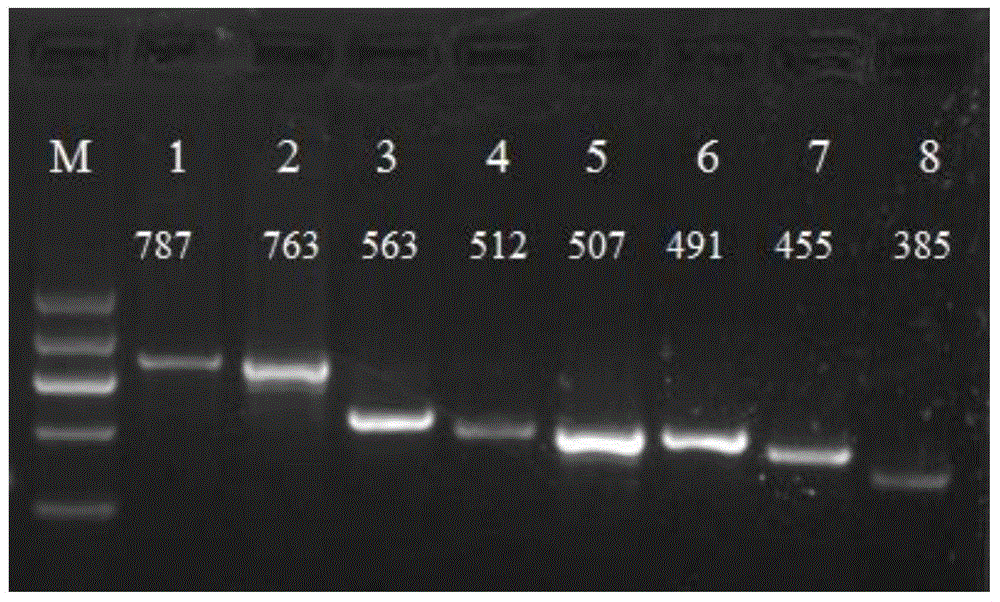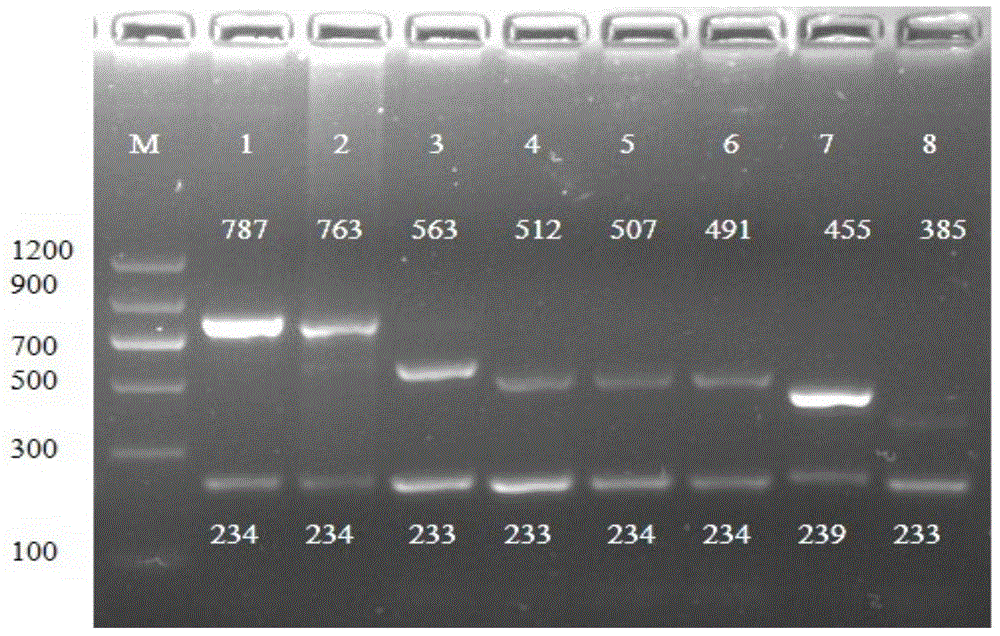PCR method for tracking source identification of origin components of eight kinds of animals
An animal-derived ingredient, goat technology, applied in biochemical equipment and methods, microbial determination/inspection, etc., can solve the problem of no identification method, save manpower and material resources, high specificity and sensitivity, and improve detection efficiency. Effect
- Summary
- Abstract
- Description
- Claims
- Application Information
AI Technical Summary
Problems solved by technology
Method used
Image
Examples
Embodiment 1
[0031] Example 1 Primer Design
[0032]According to the gene sequence published by GenBank, goat (GU229278), deer (HQ191428), swamp buffalo (AF702618), domestic cattle (EU177861), sheep (KF938337), yak (KM233416), pig (AF486867) and camel (AP003423) The complete mitochondrial DNA (mtDNA) sequence was used as a template, and the mtDNA sequences of 8 species and common species (chicken, duck, rabbit, mouse, horse, dog) were compared and analyzed. According to the specificity and conservation of their gene sequences, the Primer premier 5.0 software designed universal primers for multiple species. The primers were paired with the mtDNA sequences of the 8 bovine species mentioned above. There were insertion-deletion fragments in the amplified regions under their jurisdiction, so the size of the amplified products of each species was different. In order to improve the detection effect, two downstream primers were designed for optimization at the same time. The primer sequences are a...
Embodiment 2
[0036] Example 2 Optimization of PCR system and reaction conditions
[0037] The PCR reaction system uses a 20 μL basic system, including 2.0 μL of Buffer, 2.0 μL each of primer SEQ ID 1 and optimized primer SEQ ID 2 or SEQ ID 3, 1.6 μL of dNTP mixture, 0.2 μL of Taq DNA polymerase, MgCl 2 1.2 μL, DNA template 3.0 μL (about 30ng DNA), ddH 2 O supplemented to 20.0 μL.
[0038] According to the above PCR system, a temperature gradient (48.0-65.0° C.) is set on the gradient PCR instrument, and the annealing temperature is optimized first. The basic PCR process is as follows: denaturation at 95°C for 5 min; denaturation at 95°C for 40 s, different annealing temperatures for 30 s, and extension at 72°C for 40 s as a cycle, a total of 30 cycles; then extension at 72°C for 5 min. After the PCR product was detected by electrophoresis (4S Red agarose nucleic acid dye), the temperature of the electrophoresis band was selected as the temperature of the basic system, at which the size o...
Embodiment 3
[0041] Example 3 PCR product detection and sequence determination
[0042] In the implementation of the present invention, 2.0% agarose gel was used to separate PCR products, and 4S Red nucleic acid dye was added to the melted gel according to the instructions. After 90V constant voltage electrophoresis for 40min, take pictures and observe under the gel imaging system. The results show that the PCR products in the present invention can be cleaned and resolved to determine their size. For specific results, see figure 1 and accompanying drawings.
[0043] The PCR products of each species were recovered according to the operation instructions of the gel recovery kit, and sent to the biological company for sequencing. The sequencing results were compared with the GenBank sequence, and the online software Blast was used for comparative analysis. The similarity and matching degree were both above 98%, indicating that the source of the amplified product was completely consistent wi...
PUM
 Login to View More
Login to View More Abstract
Description
Claims
Application Information
 Login to View More
Login to View More - R&D
- Intellectual Property
- Life Sciences
- Materials
- Tech Scout
- Unparalleled Data Quality
- Higher Quality Content
- 60% Fewer Hallucinations
Browse by: Latest US Patents, China's latest patents, Technical Efficacy Thesaurus, Application Domain, Technology Topic, Popular Technical Reports.
© 2025 PatSnap. All rights reserved.Legal|Privacy policy|Modern Slavery Act Transparency Statement|Sitemap|About US| Contact US: help@patsnap.com



